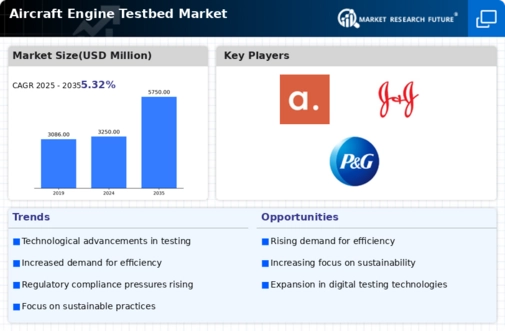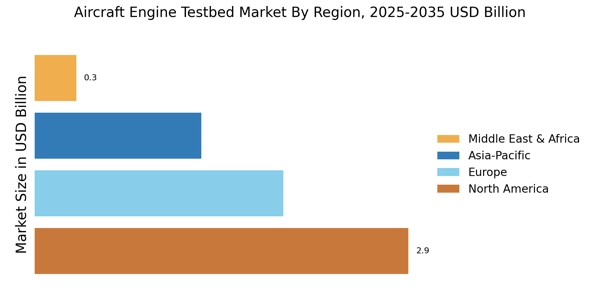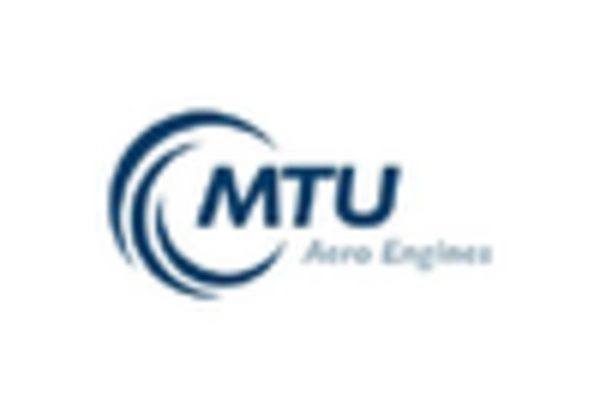Growing Investment in Aerospace R&D
The Aircraft Engine Testbed Market is witnessing a surge in investment in aerospace research and development. As competition intensifies among aircraft manufacturers, there is a pressing need to innovate and improve engine technologies. This has led to increased funding for R&D initiatives, particularly in the development of more efficient and powerful engines. Testbeds play a crucial role in this process, providing the necessary environment to validate new technologies and designs. The market is projected to grow as more companies allocate resources towards enhancing their testing capabilities, thereby fostering innovation within the Aircraft Engine Testbed Market.
Advancements in Simulation Technologies
The Aircraft Engine Testbed Market is benefiting from advancements in simulation technologies. These innovations allow for more accurate modeling and testing of engine performance, reducing the need for extensive physical testing. The integration of computational fluid dynamics and other simulation tools is transforming how engines are tested, enabling manufacturers to predict performance outcomes with greater precision. This shift not only enhances efficiency but also reduces costs associated with traditional testing methods. As simulation technologies continue to evolve, the Aircraft Engine Testbed Market is likely to see increased adoption of these tools, further streamlining the testing process and improving overall engine design.
Expansion of Commercial Aviation Sector
The Aircraft Engine Testbed Market is closely linked to the expansion of the commercial aviation sector. As air travel demand continues to rise, airlines are investing in new aircraft and engine technologies to meet passenger expectations and improve operational efficiency. This expansion necessitates the development of advanced testbeds capable of accommodating the latest engine designs and performance requirements. The market is expected to grow in tandem with the commercial aviation sector, as manufacturers seek to ensure that their engines meet the rigorous standards demanded by airlines. Consequently, the Aircraft Engine Testbed Market is likely to experience robust growth driven by the increasing need for comprehensive testing solutions.
Rising Focus on Environmental Regulations
The Aircraft Engine Testbed Market is significantly influenced by the rising focus on environmental regulations. Governments and regulatory bodies are increasingly imposing stringent emissions standards on aircraft engines, compelling manufacturers to innovate and comply with these regulations. This trend has led to a heightened demand for testbeds that can accurately assess engine emissions and performance under various conditions. The market is expected to witness a notable increase in investments aimed at developing eco-friendly testing solutions. As a result, the Aircraft Engine Testbed Market is likely to evolve, with a greater emphasis on sustainability and compliance with environmental standards, thereby driving the adoption of advanced testing technologies.
Increasing Demand for Efficient Testing Solutions
The Aircraft Engine Testbed Market is experiencing a surge in demand for efficient testing solutions. As aircraft manufacturers strive to enhance engine performance and reduce operational costs, the need for advanced testbeds becomes paramount. The market is projected to grow at a compound annual growth rate of approximately 5.2% over the next five years. This growth is driven by the increasing complexity of modern aircraft engines, which necessitates sophisticated testing environments to ensure reliability and safety. Furthermore, the integration of digital technologies in testbed operations is likely to streamline processes, thereby attracting more stakeholders to invest in state-of-the-art testing facilities. Consequently, the Aircraft Engine Testbed Market is poised for significant expansion as manufacturers seek to optimize engine performance through rigorous testing protocols.


















Leave a Comment